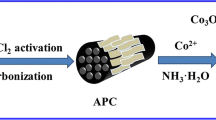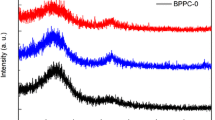Abstract
Red phosphorus (RP) is considered to be one of the promising anode materials for lithium-ion batteries (LIBs) on account of its high theoretical capacity (2596 mAh g−1), abundant resources, and environmental friendliness. However, the intrinsic insulating nature and large volume change during lithium insertion/extraction process lead to drastic capacity loss upon cycling. Recently, great attention has been devoted to constructing P-based composites via mixing with carbon materials. Here, a novel P/C composite, in which red P nanoparticles were homogeneously distributed in cigarette filter-derived porous carbon (CPC), was fabricated by vaporization-condensation method. Due to the unique characteristics of porous carbon, including high specific area, good conductivity, and rich internal porous structure, CPC obtained by means of heat treatment that serves as conductive matrix to load red P could be of great benefits, which can not only improve the overall electrical conductivity but also mitigate the volume expansion issues. As a result, the RP/CPC composite as an anode material for LIBs delivers a good cycling stability (500 mAh g−1 at 100 mA g−1 with a high Coulombic efficiency above 99% after 50 cycles) and rate capability (355 mAh g−1 even at 1000 mA g−1).










Similar content being viewed by others
References
Aricò AS, Bruce P, Scrosati B, Tarascon J-M, Schalkwijk WV (2005) Nanostructured materials for advanced energy conversion and storage devices. Nat Mater 4(5):366–377
Tarascon J-M, Armand M (2001) Issues and challenges facing rechargeable lithium batteries. Nature 414(6861):359–367
Armand M, Tarascon J-M (2008) Building better batteries. Nature 451(7179):652–657
Marom R, Amalraj SF, Leifer N, Jacob D, Aurbach D (2011) A review of advanced and practical lithium battery materials. J Mater Chem 21(27):9938–9954
Feng X, Zou H, Xiang H, Guo X, Zhou T, Wu Y, Xu W, Yan P, Wang C, Zhang J-G, Yu Y (2016) Ultrathin Li4Ti5O12 nanosheets as anode materials for lithium and sodium storage. ACS Appl Mater Interfaces 8(26):16718–16726
Zou H, Liang X, Feng X, Xiang H (2016) Chromium-modified Li4Ti5O12 with a synergistic effect of bulk doping, surface coating, and size reducing. ACS Appl Mater Interfaces 8(33):21407–21416
Zou HL, Xiang HF, Liang X, Feng XY, Cheng S, Jin Y, Chen CH (2017) Electrospun Li3.9Cr0.3Ti4.8O12 nanofibers as anode material for high-rate and low-temperature lithium-ion batteries. J Alloys Compd 701:99–106
Chan CK, Peng H, Liu G, McIlwrath K, Zhang XF, Huggins RA, Cui Y (2008) High-performance lithium battery anodes using silicon nanowires. Nat. Nanotechnol. 3(1):31–35
Xiang H, Zhang K, Ji G, Lee JY, Zou C, Chen X, Wu J (2011) Graphene/nanosized silicon composites for lithium battery anodes with improved cycling stability. Carbon 49(5):1787–1796
Lian P, Wang J, Cai D, Liu G, Wang Y, Wang H (2014) Design and synthesis of porous nano-sized Sn@C/graphene electrode material with 3D carbon network for high-performance lithium-ion batteries. J Alloys Compd 604:188–195
Xu Y, Zhu Y, Liu Y, Wang C (2013) Electrochemical performance of porous carbon/tin composite anodes for sodium-ion and lithium-ion batteries. Adv Energy Mater 3(1):128–133
Xue D-J, Xin S, Yan Y, Jiang K-C, Yin Y-X, Guo Y-G, Wan L-J (2012) Improving the electrode performance of Ge through Ge@C core-shell nanoparticles and graphene networks. J Am Chem Soc 134(5):2512–2515
Yoon S, Park C-M, Sohn H-J (2008) Electrochemical characterizations of germanium and carbon-coated germanium composite anode for lithium-ion batteries. Electrochem. Solid-State Lett. 11(4):A42–A45
Lian P, Wang J, Cai D, Ding L, Jia Q, Wang H (2014) Porous SnO2@C/graphene nanocomposite with 3D carbon conductive network as a superior anode material for lithium-ion batteries. Electrochim Acta 116:103–110
Lian P, Zhu X, Xiang H, Li Z, Yang W, Wang H (2010) Enhanced cycling performance of Fe3O4-graphene nanocomposite as an anode material for lithium-ion batteries. Electrochim Acta 56(2):834–840
Wu J, Song Y, Zhou R, Chen S, Zuo L, Hou H, Wang L (2015) Zn-Fe-ZIF-derived porous ZnFe2O4/C@NCNT nanocomposites as anodes for lithium-ion batteries. J Mater Chem A 3(15):7793–7798
Wang L, Zheng Y, Wang X, Chen S, Xu F, Zuo L, Wu J, Sun L, Li Z, Hou H, Song Y (2014) Nitrogen-doped porous carbon/Co3O4 nanocomposites as anode materials for lithium-ion batteries. ACS Appl Mater Interfaces 6(10):7117–7125
Balogun M-S, Yu M, Li C, Zhai T, Liu Y, Lu X, Tong Y (2014) Facile synthesis of titanium nitride nanowires on carbon fabric for flexible and high-rate lithium ion batteries. J Mater Chem A 2(28):10825–10829
Zhang K, Wang H, He X, Liu Z, Wang L, Gu L, Xu H, Han P, Dong S, Zhang C, Yao J, Cui G, Chen L (2011) A hybrid material of vanadium nitride and nitrogen-doped graphene for lithium storage. J Mater Chem 21(32):11916–11922
Wang X, Kim H-M, Xiao Y, Sun Y-K (2016) Nanostructured metal phosphide-based materials for electrochemical energy storage. J Mater Chem A 4(39):14915–14931
Ruan B, Wang J, Shi D, Xu Y, Chou S, Liu H, Wang J (2015) A phosphorus/N-doped carbon nanofiber composite as an anode material for sodium-ion batteries. J Mater Chem A 3(37):19011–19017
Qian J, Qiao D, Ai X, Cao Y, Yang H (2012) Reversible 3-Li storage reactions of amorphous phosphorus as high capacity and cycling-stable anodes for Li-ion batteries. Chem Commun 48(71):8931–8933
Song J, Yu Z, Gordin ML, Hu S, Yi R, Tang D, Walter T, Regula M, Choi D, Li X, Manivannan A, Wang D (2014) Chemically bonded phosphorus/graphene hybrid as a high performance anode for sodium-ion batteries. Nano Lett 14(11):6329–6335
Li W, Yang Z, Li M, Jiang Y, Wei X, Zhong X, Gu L, Yu Y (2016) Amorphous red phosphorus embedded in highly ordered mesoporous carbon with superior lithium and sodium storage capacity. Nano Lett 16(3):1546–1553
Li W-J, Chou S-L, Wang J-Z, Liu H-K, Dou S-X (2013) Simply mixed commercial red phosphorus and carbon nanotube composite with exceptionally reversible sodium-ion storage. Nano Lett 13(11):5480–5484
Sun J, Zheng G, Lee H-W, Liu N, Wang H, Yao H, Yang W, Cui Y (2014) Formation of stable phosphorus-carbon bond for enhanced performance in black phosphorus nanoparticle-graphite composite battery anodes. Nano Lett 14(8):4573–4580
Chen L, Zhou G, Liu Z, Ma X, Chen J, Zhang Z, Ma X, Li F, Cheng H-M, Ren W (2016) Scalable clean exfoliation of high-quality few-layer black phosphorus for a flexible lithium ion battery. Adv Mater 28(3):510–517
Sun L-Q, Li M-J, Sun K, Yu S-H, Wang R-S, Xie H-M (2012) Electrochemical activity of black phosphorus as an anode material for lithium-ion batteries. J Phys Chem C 116(28):14772–14779
Li W, Yang Z, Jiang Y, Yu Z, Gu L, Yu Y (2014) Crystalline red phosphorus incorporated with porous carbon nanofibers as flexible electrode for high performance lithium-ion batteries. Carbon 78:455–462
Park C-M, Sohn H-J (2007) Black phosphorus and its composite for lithium rechargeable batteries. Adv Mater 19(18):2465–2468
Stan MC, Zamory Jv PS, Nilges T, Winter M (2013) Puzzling out the origin of the electrochemical activity of black P as a negative electrode material for lithium-ion batteries. J Mater Chem A 1(17):5293–5300
Yuan D, Cheng J, Qu G, Li X, Ni W, Wang B, Liu H (2016) Amorphous red phosphorous embedded in carbon nanotubes scaffold as promising anode materials for lithium-ion batteries. J Power Sources 301:131–137
Li J, Wang L, Ren Y, Zhang Y, Wang Y, Hu A, He X (2015) Distinctive slit-shaped porous carbon encapsulating phosphorus as a promising anode material for lithium batteries. Ionics 22(2):167–172
Kim Y, Park Y, Choi A, Choi N-S, Kim J, Lee J, Ryu JH, Oh SM, Lee KT (2013) An amorphous red phosphorus/carbon composite as a promising anode material for sodium ion batteries. Adv Mater 25(22):3045–3049
Yu Z, Song J, Gordin ML, Yi R, Tang D, Wang D (2015) Phosphorus-graphene nanosheet hybrids as lithium-ion anode with exceptional high-temperature cycling stability. Adv. Sci. 2(1–2):1400020
Marino C, Debenedetti A, Fraisse B, Favier F, Monconduit L (2011) Activated-phosphorus as new electrode material for Li-ion batteries. Electrochem Commun 13(4):346–349
Li J, Wang L, He X, Wang J (2016) Effect of pore size distribution of carbon matrix on the performance of phosphorus@carbon material as anode for lithium-ion batteries. ACS Sustain Chem Eng 4(8):4217–4223
Polarz S, Smarsly B, Schattka JH (2002) Hierarchical porous carbon structures from cellulose acetate fibers. Chem Mater 14(7):2940–2945
Soltani SM, Yazdi SK, Hosseini S (2014) Effects of pyrolysis conditions on the porous structure construction of mesoporous charred carbon from used cigarette filters. Appl Nanosci 4(5):551–569
Novotny TE, Hardin SN, Hovda LR, Novotny DJ, McLean MK, Khan S (2011) Tobacco and cigarette butt consumption in humans and animals. Tob Control 20(Suppl 1):i17–i20
Sun H, La P, Yang R, Zhu Z, Liang W, Yang B, Li A, Deng W (2017) Innovative nanoporous carbons with ultrahigh uptakes for capture and reversible storage of CO2 and volatile iodine. J Hazard Mater 321:210–217
Yazdi SK, Soltani SM, Hosseini S (2012) An investigation into the optimum carbonization conditions for the production of porous carbon from a solid waste. Adv Mater Res 587:88–92
Lee M, Kim G-P, Song HD, Park S, Yi J (2014) Preparation of energy storage material derived from a used cigarette filter for a supercapacitor electrode. Nanotechnology 25(34):345601
Ali Z, Tahir M, Cao C, Mahmood A, Mahmood N, Butt FK, Tanveer M, Shakir I, Rizwan M, Idrees F, Aslam I, Zou J-J (2016) Solid waste for energy storage material as electrode of supercapacitors. Mater Lett 181:191–195
Lu P, Sun Y, Xiang H, Liang X, Yu Y (2017) 3D amorphous carbon with controlled porous and disordered structures as a high-rate anode material for sodium-ion batteries. Adv Energy Mater:1702434
Wang Y, Su F, Wood CD, Lee JY, Zhao XS (2008) Preparation and characterization of carbon nanospheres as anode materials in lithium-ion secondary batteries. Ind Eng Chem Res 47(7):2294–2300
Puls J, Wilson SA, Hölter D (2010) Degradation of cellulose acetate-based materials: a review. J Polym Environ 19(1):152–165
Zaug JM, Soper AK, Clark SM (2008) Pressure-dependent structures of amorphous red phosphorus and the origin of the first sharp diffraction peaks. Nat Mater 7(11):890–899
Wang L, He X, Li J, Sun W, Gao J, Guo J, Jiang C (2012) Nano-structured phosphorus composite as high-capacity anode materials for lithium batteries. Angew Chem 51(36):9034–9037
Wu Z-S, Ren W, Xu L, Li F, Chen H-M (2011) Doped graphene sheets as anode materials with superhigh rate and large capacity for lithium ion batteries. ACS Nano 5(7):5463–5471
Puziy AM, Poddubnaya OI, Martínez-Alonso A, Suárez-García F, Tascón JMD (2005) Surface chemistry of phosphorus-containing carbons of lignocellulosic origin. Carbon 43(14):2857–2868
Puziy AM, Poddubnaya OI, Socha RP, Gurgul J, Wisniewski M (2008) XPS and NMR studies of phosphoric acid activated carbons. Carbon 46(15):2113–2123
Li W-J, Chou S-L, Wang J-Z, Liu H-K, Dou S-X (2016) Significant enhancement of the cycling performance and rate capability of the P/C composite via chemical bonding (P–C). J Mater Chem A 4(2):505–511
Wang Y, Tian L, Yao Z, Li F, Li S, Ye S (2015) Enhanced reversibility of red phosphorus/active carbon composite as anode for lithium ion batteries. Electrochim Acta 163:71–76
Chen A, Li Y, Yu Y, Li Y, Zhang L, Lv H, Liu L (2015) Mesoporous carbonaceous materials prepared from used cigarette filters for efficient phenol adsorption and CO2 capture. RSC Adv 5(130):107299–107306
Marino C, Boulet L, Gaveau P, Fraisse B, Monconduit L (2012) Nanoconfined phosphorus in mesoporous carbon as an electrode for Li-ion batteries: performance and mechanism. J Mater Chem 22(42):22713–22720
Zhu Y, Wen Y, Fan X, Gao T, Han F, Luo C, Liou S-C, Wang C (2015) Red phosphorus-single-walled carbon nanotube composite as a superior anode for sodium ion batteries. ACS Nano 9(3):3254–3264
Smajic J, Alazmi A, Patole SP, Costa PMFJ (2017) Single-walled carbon nanotubes as stabilizing agents in red phosphorus Li-ion battery anodes. RSC Adv 7(63):39997–40004
Funding
This work was financially supported by the National Natural Science Foundation of China (No. 21406098), the Natural Science Foundation of Yunnan Province (No. 2016FB018), and the Project of Youth Academic and Technology talents of Yunnan Province (No. 2015HB022).
Author information
Authors and Affiliations
Corresponding authors
Rights and permissions
About this article
Cite this article
Wang, Q., Lian, P., Wang, B. et al. Red phosphorus encapsulated in porous carbon derived from cigarette filter solid waste as a promising anode material for lithium-ion batteries. Ionics 24, 3393–3403 (2018). https://doi.org/10.1007/s11581-018-2487-5
Received:
Revised:
Accepted:
Published:
Issue Date:
DOI: https://doi.org/10.1007/s11581-018-2487-5




